Depending on packages for which an ABI matters
When a library exposes an API in a compiled language, any other library or package that uses that API has to concern themselves with the ABI (Application Binary Interface) as soon as the API provider and API consumer are distributed separately. As a rule, it's best for ABI compatibility if the different packages are built with the same compiler toolchain, command-line flags and other configuration options. If that is not possible or guaranteed, one has to start thinking carefully about whether the two build environments will result in packages that are ABI-compatible.
There are a lot of things with an ABI that a Python library maintainer may have to care about:
- The C standard library (the
libcflavor) - The C++ standard library (
libstdc++old vs. new string ABI,libc++, MSVC runtime, etc.) - Fortran (gfortran vs. g77 ABI)
- CPython
- Python packages with C APIs: (NumPy, SciPy)
- Python packages with C++ APIs (PyTorch, Apache Arrow - see complex C++ dependencies)
- Common non-Python dependencies for scientific computing BLAS, LAPACK, OpenMP, MPI1 (see mpich.org/abi).
For some more background on ABI, see here.
Current state
A package manager has to know about ABI, either implicitly or explicitly. In
the case of PyPI, it's implicit. There are conventions that anyone publishing a
wheel should adhere to. For example, on Windows and macOS, use compilers and
flags compatible with those used to produce the Python installers published on
python.org. And on Linux, what the various
manylinux PEPs say (more complex, so best to use the manylinux-provided
Docker images).
Other package managers are more explicit about managing ABI, to varying degrees. They also have the advantage of being able to enforce using a consistent compiler toolchain. Inspecting the dependency tree of a SciPy install (which uses the Python and NumPy C APIs/ABIs) will show this:
$ pipdeptree -p scipy
scipy==1.9.3
- numpy [required: >=1.18.5,<1.26.0, installed: 1.23.5]
$ # Note: output edited to remove duplicate packages and python's dependencies
$ mamba repoquery depends scipy --tree
scipy[1.9.3]
├─ libgfortran-ng[12.1.0]
│ └─ libgfortran5[12.1.0]
├─ libgcc-ng[12.1.0]
│ ├─ _libgcc_mutex[0.1]
│ └─ _openmp_mutex[4.5]
│ └─ llvm-openmp[14.0.4]
│ └─ libzlib[1.2.13]
├─ libstdcxx-ng[12.1.0]
├─ python_abi[3.10]
│ └─ python[3.10.8]
└─ numpy[1.23.3]
├─ libblas[3.9.0]
│ └─ libopenblas[0.3.21]
├─ libcblas[3.9.0]
├─ liblapack[3.9.0]
├─ libblas already visited
├─ liblapack already visited
$ # Note: output edited to remove build-only dependencies
$ ./spack spec py-scipy%gcc
py-scipy@1.9.2%gcc@12.2.0 arch=linux-endeavourosrolling-skylake_avx512
^openblas@0.3.21%gcc@12.2.0~bignuma~consistent_fpcsr+fortran~ilp64+locking+pic+shared symbol_suffix=none threads=none arch=linux-endeavourosrolling-skylake_avx512
^python@3.9.13%gcc@12.2.0+bz2+ctypes+dbm~debug+libxml2+lzma~nis~optimizations+pic+pyexpat+pythoncmd+readline+shared+sqlite3+ssl~tix~tkinter~ucs4+uuid+zlib patches=0d98e93,4c24573,f2fd060 arch=linux-endeavourosrolling-skylake_avx512
^py-numpy@1.23.3%gcc@12.2.0+blas+lapack patches=873745d arch=linux-endeavourosrolling-skylake_avx512
$ # Note: output edited to remove duplicates and some transitive dependencies
$ pactree python-scipy
python-scipy
└─python-numpy
├─cblas
│ └─openblas provides blas
│ └─gcc-libs
│ └─glibc>=2.27
├─lapack
│ └─openblas provides blas
└─python
├─bzip2
│ ├─glibc
├─expat
├─gdbm
├─libffi
├─libnsl
├─libxcrypt
├─openssl
└─zlib
% # Note: output edited to remove duplicate packages
% brew deps --tree --installed scipy
scipy
├── gcc
│ ├── gmp
│ ├── isl
│ ├── libmpc
│ ├── mpfr
│ └── zstd
│ ├── lz4
│ └── xz
├── numpy
│ └── openblas
│ └── gcc
├── openblas
│ └── gcc
└── python@3.11
├── mpdecimal
├── openssl@1.1
├── sqlite
└── xz
For example, we see python_abi and libgcc_mutex in the conda-forge output;
detailed compiler, BLAS interface, CPU architecture and library info in the
Spack output; and glibc version info in the Arch Linux output.
In general, the more dependencies and more languages one uses, the more ABI compatibility starts to matter. If the Python C API is the only thing used by a package, the rules are relatively straightforward: rebuild for every minor Python version (unless one can use the limited API, then it's even easier), with compatible compilers.
It already gets a lot harder as soon as one uses the NumPy C API. Which many packages do, often via Cython. While the NumPy ABI is much more stable than the CPython one (NumPy hasn't broken compatibility in a nontrivial way in over a decade), one still has to understand the rules for building against NumPy:
Example: Using the NumPy C API
NumPy has a C API, which Cython, SciPy, and many other packages use. That
ABI is forward but not backward compatible, meaning if you use it then you
must build your wheels against the lowest NumPy version that you expect
your users to use. So if you build against version 1.X.Y then the runtime
requirement you get is numpy>=1.X.Y. That lowest version may depend on
Python version and platform. There is no good way to express a dependency
like that in pyproject.toml, or even to keep track of what the lowest
version should be. Because of that, the
oldest-supported-numpy
metapackage is being used by projects that depend on numpy as an
imperfect hack to obtain the correct numpy== build requirement pins per
Python version and platform. It can be used like so:
[build-system]
requires = [
"oldest-supported-numpy",
# your other build requirements here
]
oldest-supported-numpy is updated so that each user of the NumPy C API
does not have to do that.
Despite this complexity, the solution is imperfect -
oldest-supported-numpy is unable to communicate back the correct
numpy>= runtime requirement, so those requirements are generally
incorrect for all packages using NumPy (all wheels will have a generic
numpy>=1.Y.Z for the lowest value of 1.Y.Z across all wheels).
See Adding a dependency on NumPy for more details.
The most difficult cases arise with dependencies outside of Python/PyPI (also see native dependencies). At that point one can pick up arbitrary libraries during the build phase of a package, and with complex dependencies the ABI of that dependency may be unknown or have to be introspected. This paper on SciPy's Cython API for BLAS and LAPACK explains how and why SciPy added a Cython API to hide the ABI variations across BLAS/LAPACK implementations from other Python packages.
These three "levels of complexity" cases are illustrated by these diagrams of package stacks:
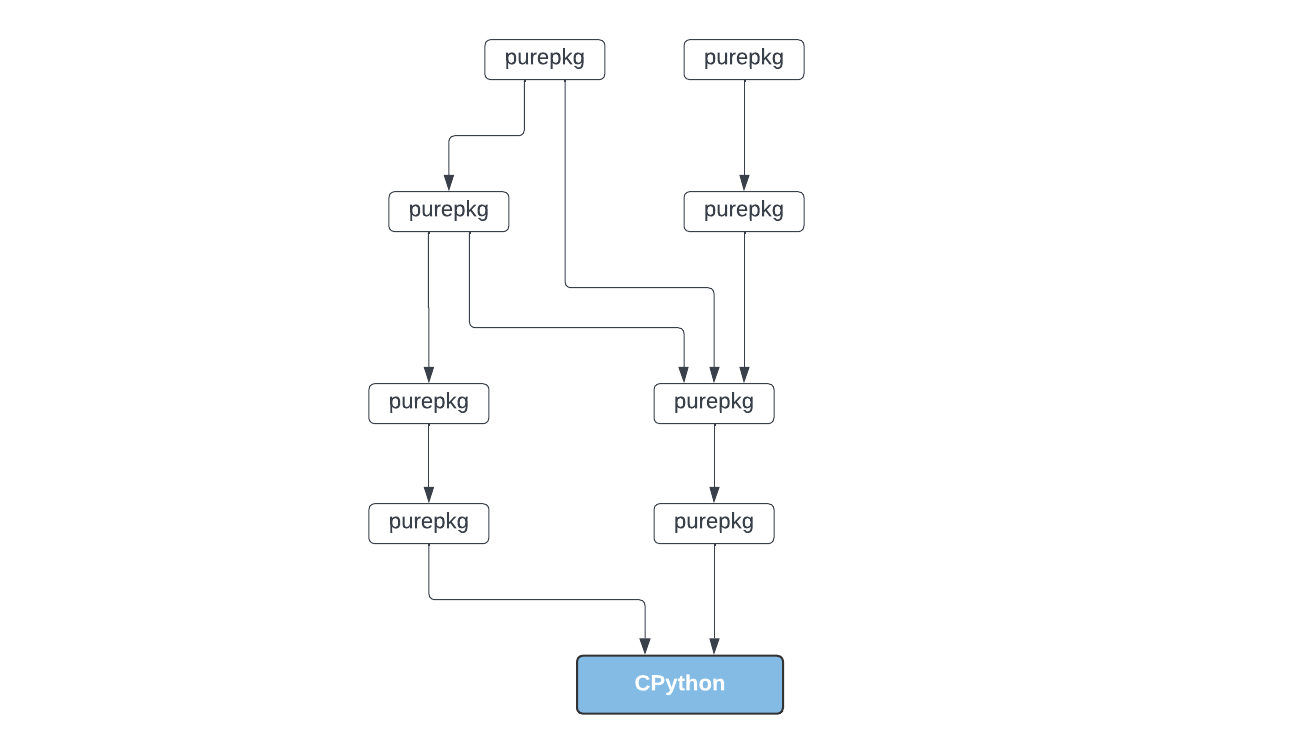
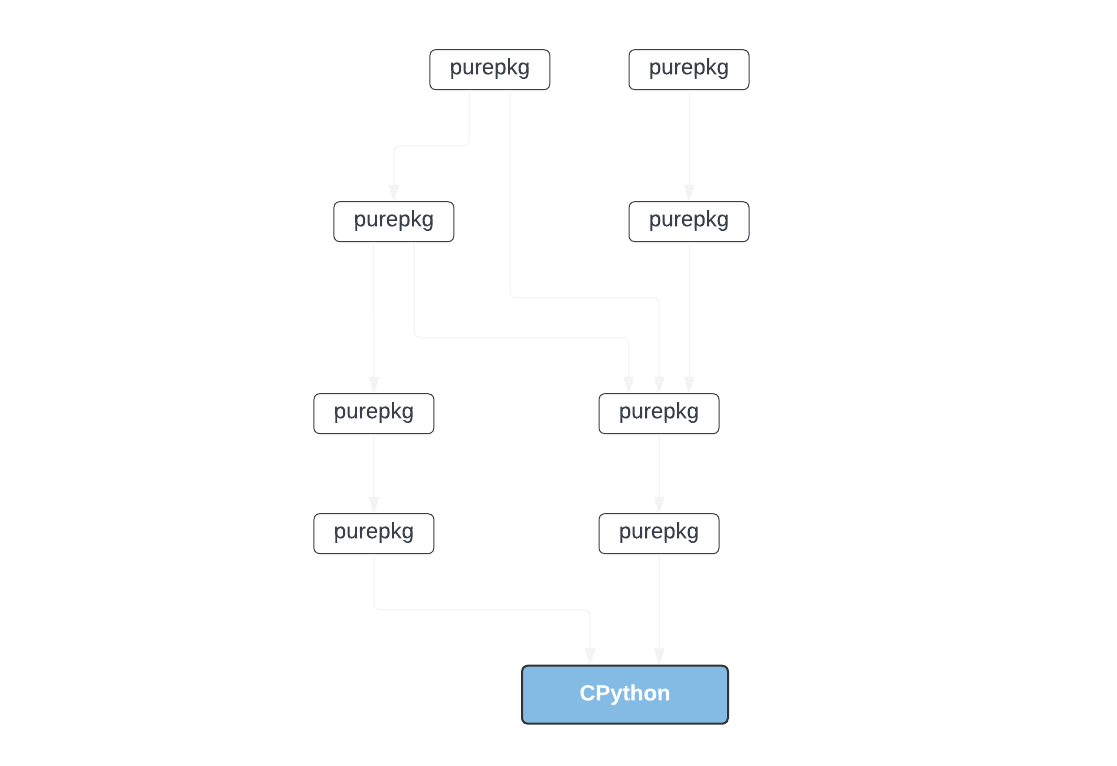
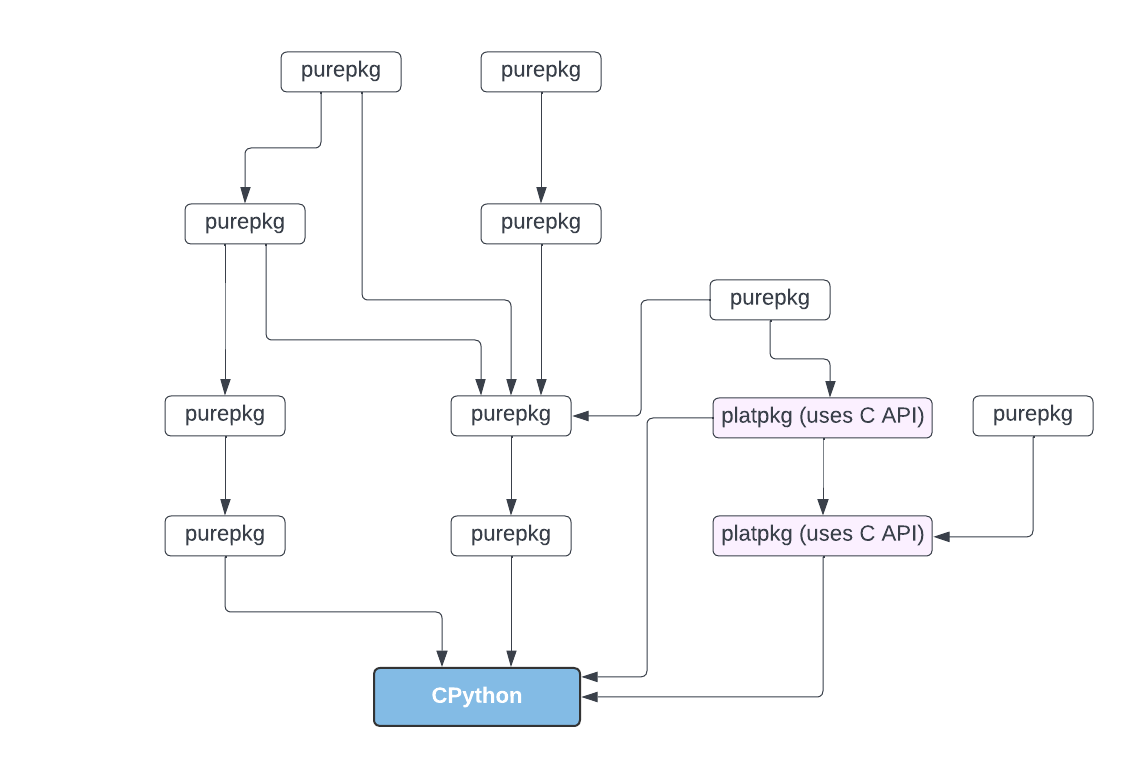

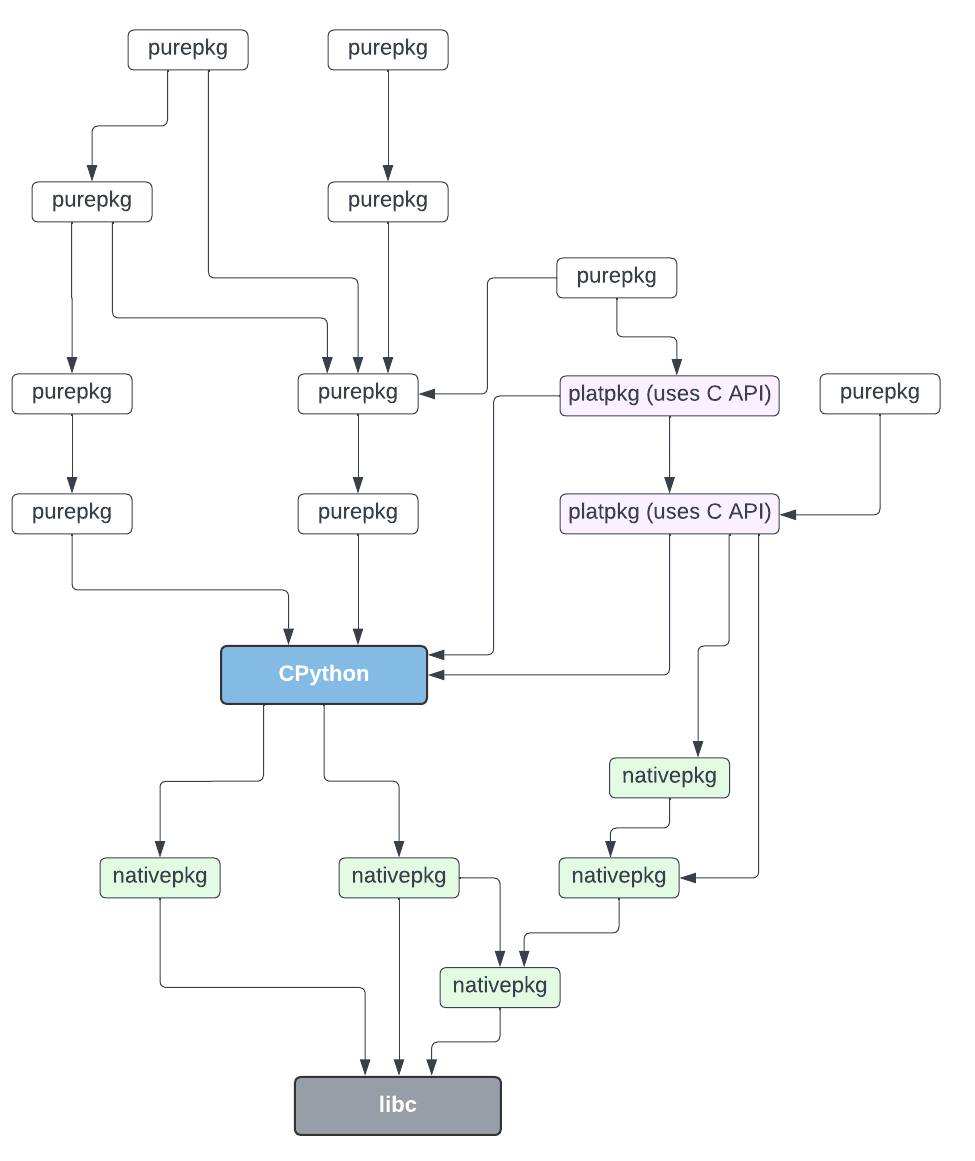
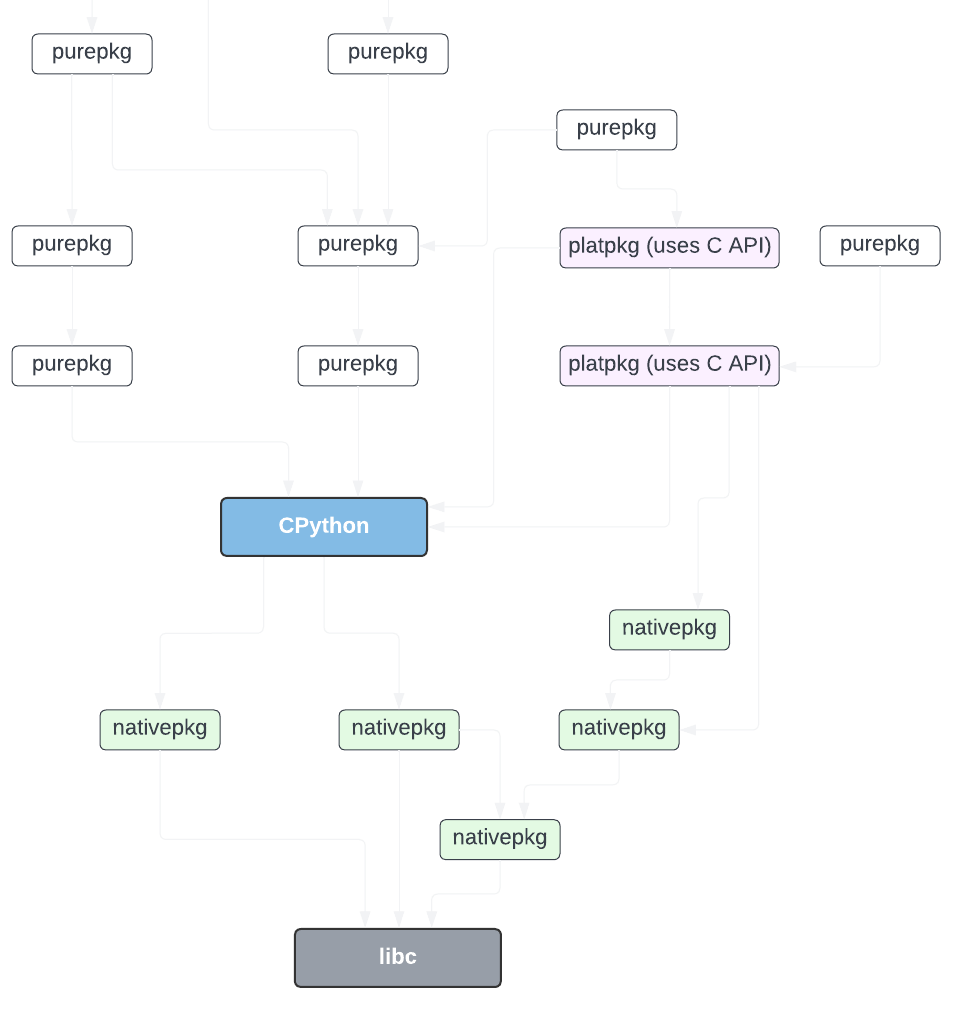
libc
C++ APIs are a problem onto themselves. When a library is written in C++ but
wants to expose an API with a stable ABI, it often exposes a C rather than a
C++ API with extern "C". Keeping ABI stability has a large cost though, it
takes a lot of extra work and may prevent changes to internals of a library.
Hence it's not always done. For example, PyTorch has a large C++ API and does
not promise any ABI stability:
Example: Using the PyTorch C++ API
PyTorch is mostly written in C++, and exposes a C++ API in addition to its Python API. C++ ABI stability is a tricky topic - it's implementation-defined, and because name mangling can change between compilers (or even compiler versions), mixing binaries built with different compilers isn't possible. PyTorch does not attempt to provide a stable ABI; even bug fix releases aren't guaranteed to be compatible. As a result, all packages using PyTorch's C API must use a runtime requirement like:
[project]
dependencies = [
"torch == X.Y.Z", # X.Y.Z is the version of PyTorch used to build against
]
This requirement also implies synchronized releases. If PyTorch does a
new release, the team ensures that simultaneous releases of torchvision,
torchaudio, torchtext, torchdata and other dependent packages are
made. This level of coordination doesn't scale well though, and therefore
may limit the use of the PyTorch C++ API - especially by community open
source projects whose authors may not have the bandwidth to keep up with
releases.
The project description for pypi/torchvision is a good example to illustrate the tight version coupling.
Problems
A problem for PyPI and wheels is that there is little coordination on compiler
toolchains, ABI changes, etc. So maintainers of every package are on their own
trying to figure this out. Other package managers don't have this problem -
they build everything with a consistent toolchain (as much as possible at
least), either including libc or on top of the libc provided by the
operating system. See no build farm and
PyPI's author-led social model for more details.
CPython breaks its ABI every minor release (unless one's needs are limited, then there is the limited API). This has a huge cost: packages have to build wheels for every minor Python release.
NumPy is effectively forced to do the opposite: NumPy needs to not break its ABI in order to avoid exploding the build matrix of every project using its C API. This has a large opportunity cost; there are a lot of improvements and cleanups that NumPy cannot implement. If PyPI either had a build farm or could be disregarded for binaries with ABI stability requirements, NumPy would have broken ABI compatibility multiple times by now2, with positive impacts on maintainability, performance, and functionality.
Python packaging build tooling has no understanding of ABI constraints, making it hard to add runtime version constraints to a wheel that are correct (and tighter than those in the corresponding sdist).
Manylinux versions still using the old C++ ABI, while most C++ projects want to
use the new ABI. manylinux_2_28 may change this finally, but isn't yet in use.
See complex C++ dependencies for more
details on this topic.
History
TODO
Relevant resources
- "Circumventing the Linker: using SciPy’s BLAS and LAPACK within Cython", Ian Henriksen, SciPy 2015.
- "
archspec: A library for detecting, labeling, and reasoning about microarchitectures", Culpo et al. (2020). - "C++ binary compatibility between Visual Studio versions"
- GCC docs on
libstdc++dual ABI and on ABI Policy and Guidelines. - NumPy docs for downstream package authors.
- PEP 384 - Defining a Stable ABI.
- PEP 652 - Maintaining the Stable ABI.
- Python docs on C API Stability.
- "Let’s get rid of the stable ABI, but keep the limited API" thread on Discourse (2022).
- trailofbits/abi3audit.
- "ABI compatibility in Python: How hard could it be?" (2022).
- HPy - A better C API for Python.
- Conda-forge FAQ entry on "How to handle breaking of a package due to ABI incompatibility?".
Potential solutions or mitigations
- Expressing constraints imposed by an ABI on versions at runtime can be done
with something like conda-forge's
pin_compatibleandrun_exportsfeatures. See meson-python#29 for ideas about implementing that in a build backend. - HPy and its hybrid and universal ABIs may be the way forward for improvements in constraints that the CPython ABI imposes, as well as enabling use of alternative interpreters.
- Coordinated rebuilds that are needed because of
==runtime constraints would be a lot easier with a build farm (as discussed here).
-
h5pyis an example of a project that support MPI but, despite regular user requests, does not ship MPI-enabled wheels. MPI has multiple implementations, and does not have a stable ABI (see, e.g., mpi-issues#654 for (lack of) MPI ABI stability). ↩ -
Actually, NumPy did break its ABI once, in the 1.4.0 release (2010). This resulted in some mayhem and very long and painful discussions. The ABI was unbroken, and hasn't been touched since. ↩